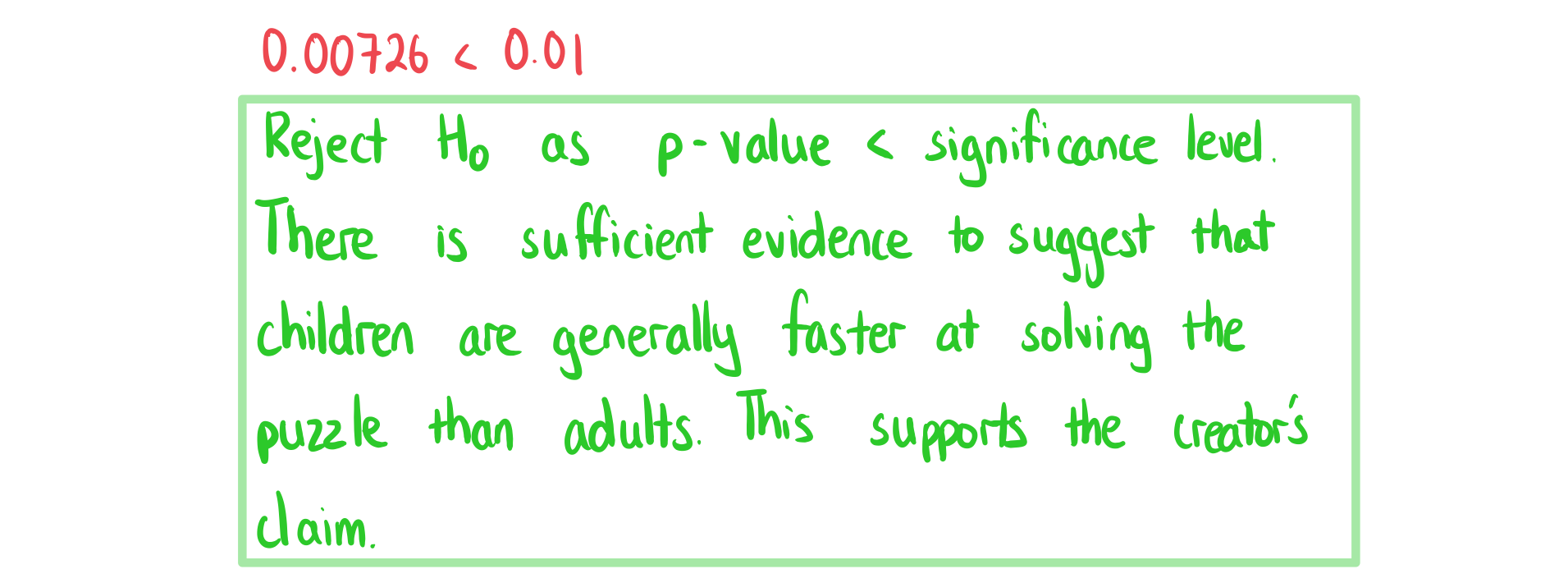4.7.4 The t-test
Two-Sample Tests
What is a t-test?
- A t-test is used to compare the means of two normally distributed populations
- In the exam the population variance will always be unknown
What assumptions are needed for the t-test?
- The underlying distribution for each variable must be normal
- In the exam you will need to assume the variance for the two groups are equal
- You will need to use the pooled two-sample t-test
What are the steps for a pooled two-sample t-test?
- STEP 1: Write the hypotheses
- H0 : μx = μy
- Where μx and μy are the population means
- Make sure you make it clear which mean corresponds to each population
- In words this means the two population means are equal
- H1 : μx < μy or H1 : μx > μy or H1 : μx ≠ μy
- The alternative hypothesis will depend on what is being tested (see sections for one-tailed and two-tailed tests)
- H0 : μx = μy
- STEP 2: Enter the data into your GDC
- Enter two lists of data – one for each sample
- Choose the pooled option
- Your GDC will then give you the p-value
- STEP 3: Decide whether there is evidence to reject the null hypothesis
- Compare the p-value with the given significance level
- If p-value < significance level then reject H0
- If p-value > significance level then accept H0
- Compare the p-value with the given significance level
- STEP 4: Write your conclusion
- If you reject H0
- There is sufficient evidence to suggest that the population mean of X is bigger than/smaller than/different to the population mean of Y
- This will depend on the alternative hypothesis
- If you accept H0
- There is insufficient evidence to suggest that the population mean of X is bigger than/small than/different to the population mean of Y
- Therefore this suggests that the population means are equal
- If you reject H0
One-tailed Tests
How do I perform a one-tailed t-test?
- A one-tailed test is used to test one of the two following cases:
- The population mean of X is bigger than the population mean of Y
- The alternative hypothesis will be: H1 : μx > μy
- Look out for words such as increase, bigger, higher, etc
- The population mean of X is smaller than the population mean of Y
- The alternative hypothesis will be: H1 : μx < μy
- Look out for words such as decrease, smaller, lower, etc
- The population mean of X is bigger than the population mean of Y
- If you reject the null hypothesis then
- This suggests that the population mean of X is bigger than the population mean of Y
- If the alternative hypothesis is H1 : μx > μy
- This suggests that the population mean of X is smaller than the population mean of Y
- If the alternative hypothesis is H1 : μx < μy
- This suggests that the population mean of X is bigger than the population mean of Y
Worked example
The times (in minutes) for children and adults to complete a puzzle are recorded below.
|
Children |
3.1 |
2.7 |
3.5 |
3.1 |
2.9 |
3.2 |
3.0 |
2.9 |
|
|
|
Adults |
3.1 |
3.6 |
3.5 |
3.6 |
2.9 |
3.6 |
3.4 |
3.6 |
3.7 |
3.0 |
The creator of the puzzle claims children are generally faster at solving the puzzle than adults. A t-test is to be performed at a 1% significance level.
a)
Write down the null and alternative hypotheses.

b)
Find the p-value for this test.

c)
State whether the creator’s claim is supported by the test. Give a reason for your answer.

Two-tailed Tests
How do I perform a two-tailed t-test?
- A two-tailed test is used to test the following case:
- The population mean of X is different to the population mean of Y
- The alternative hypothesis will be: H1 : μx ≠ μy
- Look out for words such as change, different, not the same, etc
- The population mean of X is different to the population mean of Y
- If you reject the null hypothesis then
- This suggests that the population mean of X is different to the population mean of Y
- You can not state which one is bigger as you were not testing for that
- All you can conclude is that there is evidence that the means are not equal
- To test whether a specific one is bigger you would need to use a one-tailed test
Worked example
In a school all students must study either French or Spanish as well as maths. 18 students in a maths class complete a test and their scores are recorded along with which language they study.
|
Studies French |
61 |
82 |
77 |
80 |
99 |
69 |
75 |
71 |
81 |
|
Studies Spanish |
74 |
79 |
83 |
66 |
95 |
79 |
82 |
81 |
85 |
The maths teacher wants to investigate whether the scores are different between the students studying each language. A t-test is to be performed at a 10% significance level.
a)
Write down the null and alternative hypotheses.

b)
Find the p-value for this test.

c)
Write down the conclusion to the test. Give a reason for your answer.


You've read 0 of your 0 free revision notes
Get unlimited access
to absolutely everything:
- Downloadable PDFs
- Unlimited Revision Notes
- Topic Questions
- Past Papers
- Model Answers
- Videos (Maths and Science)
Did this page help you?
